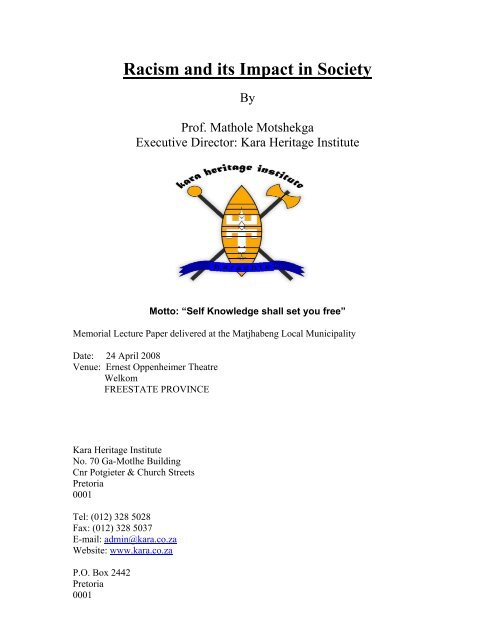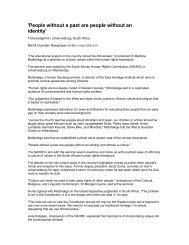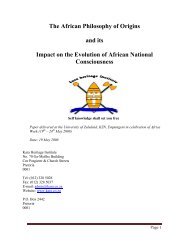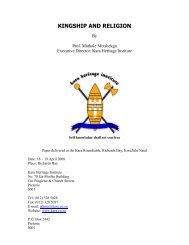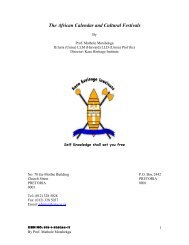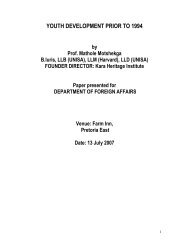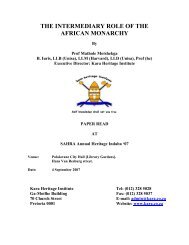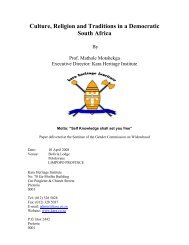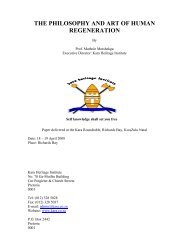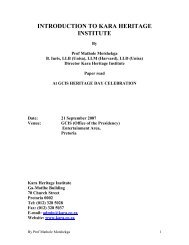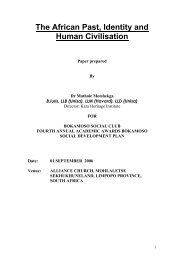Racism and its Impact in Society.pdf - Kara.co.za
Racism and its Impact in Society.pdf - Kara.co.za
Racism and its Impact in Society.pdf - Kara.co.za
Create successful ePaper yourself
Turn your PDF publications into a flip-book with our unique Google optimized e-Paper software.
<strong>Racism</strong> <strong>and</strong> <strong>its</strong> <strong>Impact</strong> <strong>in</strong> <strong>Society</strong><br />
By<br />
Prof. Mathole Motshekga<br />
Executive Director: <strong>Kara</strong> Heritage Institute<br />
Motto: “Self Knowledge shall set you free”<br />
Memorial Lecture Paper delivered at the Matjhabeng Local Municipality<br />
Date: 24 April 2008<br />
Venue: Ernest Oppenheimer Theatre<br />
Welkom<br />
FREESTATE PROVINCE<br />
<strong>Kara</strong> Heritage Institute<br />
No. 70 Ga-Motlhe Build<strong>in</strong>g<br />
Cnr Potgieter & Church Streets<br />
Pretoria<br />
0001<br />
Tel: (012) 328 5028<br />
Fax: (012) 328 5037<br />
E-mail: adm<strong>in</strong>@kara.<strong>co</strong>.<strong>za</strong><br />
Website: www.kara.<strong>co</strong>.<strong>za</strong><br />
P.O. Box 2442<br />
Pretoria<br />
0001
Introduction<br />
The democratic breakthrough of 1994 has offered us the real opportunity to address<br />
challenges which have faced us for centuries. Chief amongst these is racism, gender,<br />
class <strong>and</strong> underdevelopment. In 1900 W.E.B Du Bois said that the <strong>co</strong>lor l<strong>in</strong>e will be the<br />
greatest problem of the 20 th century.<br />
We are now <strong>in</strong> the 21 st century that we call the African Century. However, the legacy of<br />
Apartheid is still with us. The well known <strong>in</strong>cident that took place at the University of<br />
Free State <strong>and</strong> the article by David Bullard <strong>in</strong> the Sunday times are symptoms of the<br />
underly<strong>in</strong>g challenges of racism <strong>and</strong> ignorance <strong>in</strong> our beloved <strong>co</strong>untry.<br />
This Legacy of racism <strong>and</strong> ignorance cannot be addressed by the exchange of <strong>in</strong>sults <strong>and</strong><br />
endless campaigns because they are subtle <strong>and</strong> <strong>in</strong>tangible. They can only be rooted out<br />
by a systematic practical programme of historical <strong>co</strong>ntextual human rights education.<br />
It is hearten<strong>in</strong>g to know that the Hon. Major of Matjhabeng <strong>and</strong> her <strong>co</strong>uncil are already<br />
mak<strong>in</strong>g tangible progress <strong>in</strong> reach<strong>in</strong>g out to the poor <strong>and</strong> vulnerable of all <strong>co</strong>mmunities,<br />
both black <strong>and</strong> white, <strong>and</strong> that the white <strong>co</strong>mmunity <strong>in</strong> this town has already began to<br />
reach out to the black townships. It is also hearten<strong>in</strong>g to know that the major <strong>and</strong> her<br />
team takes seriously the heritage of all <strong>co</strong>mmunities <strong>and</strong> appreciates the role of our<br />
diverse cultures <strong>in</strong> build<strong>in</strong>g the character of the youth.<br />
In our celebration of Freedom Day 2008 we need to pause <strong>and</strong> reflect on the historical<br />
factors that created <strong>and</strong> nurtures racism. It is often easy to simply blame <strong>co</strong>lonialism <strong>and</strong><br />
apartheid <strong>and</strong> sometimes the defunct National Party for this <strong>in</strong>human attitude of racism.<br />
<strong>Racism</strong> is rooted deeply <strong>in</strong> the history of humank<strong>in</strong>d <strong>and</strong> it’s l<strong>in</strong>ked with the falsification<br />
of human history <strong>and</strong> <strong>its</strong> perpetuation by some religious <strong>and</strong> educational <strong>in</strong>stitutions. The<br />
basis of racism is that African people are a subhuman race, who are <strong>in</strong>herently <strong>in</strong>ferior to<br />
white people <strong>and</strong> have not <strong>co</strong>ntributed to the development of human civilisation.<br />
In this Memorial Lecture:-<br />
• We deal with the image of the African people <strong>in</strong> antiquity<br />
• The <strong>co</strong>ntribution of African people to the development of human civilisation<br />
• The destruction of African civilisation by the slave trade <strong>and</strong> <strong>co</strong>lonialism<br />
• The rebirth of African Civilisation <strong>and</strong> <strong>in</strong> particular, a revolutionary, moral vision<br />
which guided the founders of our democracy.<br />
• The challenges of class, gender <strong>and</strong> racism after the 1994 democratic<br />
breakthrough <strong>and</strong> the possible strategies for address<strong>in</strong>g these challenges<br />
• The revolutionary task of work<strong>in</strong>g together, both black <strong>and</strong> white, to build a<br />
car<strong>in</strong>g society.<br />
African people know a lot about whites, their culture <strong>and</strong> religion <strong>and</strong> try to imitate them<br />
all the time. Whites know blacks as their drawers of water <strong>and</strong> hewers of wood. It is this<br />
2
ignorance that natures racism. In 2012 the ANC, organizer <strong>and</strong> leader of South African<br />
people will be celebrat<strong>in</strong>g <strong>its</strong> centenary while racism is still alive.<br />
Let this well organized memorial Lecture mark the beg<strong>in</strong>n<strong>in</strong>g of a systematic <strong>and</strong><br />
practical programme for the total eradication of racism.<br />
The African Image <strong>in</strong> Antiquity<br />
Greeks were the first Europeans to <strong>co</strong>me <strong>in</strong>to <strong>co</strong>ntact with <strong>and</strong> about <strong>in</strong>degeneous African<br />
people. The early Greeks called these Africans the blameless Ethiopians. Ac<strong>co</strong>rd<strong>in</strong>g<br />
Homer, the Ethiopians were so pious that the gods attended their annual banquets <strong>and</strong><br />
d<strong>in</strong>ed with them. The Olympian Gods also visited Ethiopia to d<strong>in</strong>e with the African God<br />
<strong>and</strong> people.<br />
After the decl<strong>in</strong>e of the Egyptian New K<strong>in</strong>gdom under the Ramesside dynasty the<br />
Ethiopians evaded Egypt, expelled the Libyan rulers <strong>and</strong> established the Ethiopian (or<br />
25 th ) dynasty which ruled Egypt far more than 100 years. The Ethiopians revived the<br />
Egyptian Civilisation <strong>and</strong> <strong>in</strong> particular the sacred knowledge (Gnosis) which the<br />
Ethiopian founders of Egypt had <strong>in</strong>troduced <strong>in</strong>to this <strong>co</strong>untry at the beg<strong>in</strong>n<strong>in</strong>g of dynastic<br />
Egypt. Among the sacred literature published by the Ethiopians was the Sabaka Stone<br />
which <strong>co</strong>nta<strong>in</strong>ed the African ac<strong>co</strong>unt of creation of the universe <strong>and</strong> humanity. The<br />
Sabaka Stone <strong>co</strong>nta<strong>in</strong>s the Memphite theology which says Ptah, the <strong>in</strong>degeneous African<br />
creator God, created the universe <strong>and</strong> humanity through his M<strong>in</strong>d <strong>and</strong> Word. The African<br />
Sage, Khem or ThauThau-Harama (Greek Thoth-Hermes), wrote <strong>in</strong> the <strong>co</strong>rpus Hermetica<br />
that the M<strong>in</strong>d (Atum) is the father <strong>and</strong> the Word (Ham/Cham) of Ptah is the son.<br />
The M<strong>in</strong>d (Atum) of Ptah appeared <strong>in</strong> the form of the Div<strong>in</strong>e Light (<strong>Kara</strong>/Hara) whilst<br />
the Word (Ham/Cham) appeared <strong>in</strong> the form of Sound or the Voice of Light (Mbekara) or<br />
the Sun (Mbire). Thus <strong>in</strong> African theology God is perceived as Light (Ramasedi) or<br />
Sound (Lentswi).<br />
Greek Scholars visited Egypt dur<strong>in</strong>g the reign of the Ethiopian (or 25 th ) dynasty <strong>and</strong><br />
learned about African sacred knowledge (Gnosis). The Ethiopian dynasty of Egypt was<br />
overthrown by the Assyrian who ruled for a short while before they were overthrown by<br />
the Native Saite dynasty led by Pharaoh Amasis who <strong>in</strong>herited the Ethiopian legacy.<br />
In his war aga<strong>in</strong>st the Assyrians Amasis employed Greek Mercenaries. After the war<br />
Amasis allowed the Greek traders to settle <strong>in</strong> Egypt, build their town of Naucratis <strong>and</strong><br />
temples. This settlement gave the Greeks a unique opportunity to learn African sacred<br />
knowledge. Early Greek scholars <strong>in</strong>clud<strong>in</strong>g Thales, Pythagoras, Solon, the Greek<br />
lawgiver, studied <strong>in</strong> Egypt. Later Saite dynasty was overthrown by the Persians who<br />
were, <strong>in</strong> turn overthrown by Alex<strong>and</strong>er the Great, founder of the Grae<strong>co</strong>-Macedonian<br />
dynasty. Alex<strong>and</strong>er was succeeded by Ptalamu Meri-Amun Satare (Greek Ptolemy<br />
Maryam Soter) 1, Alex<strong>and</strong>er’s trusted general of African orig<strong>in</strong>s.<br />
3
Ptolemy Maryam established the Ptolemaic dynasty that translated the writ<strong>in</strong>gs of the<br />
African Sage, Khem or Thoth-Hermes, <strong>in</strong>to Greek to make them accessible to the<br />
multicultural society of Alex<strong>and</strong>ria. He also elevated African religion to an imperial<br />
religion. To this end Ptolemy <strong>co</strong>mmissioned Manetho, a High Priest of Annu (Hebrew<br />
On i.e the city of the Sun) to translate the Khemetic or Hermetic writ<strong>in</strong>gs <strong>in</strong>to Greek <strong>and</strong><br />
thus passed African Sacred Knowledge (Gnosis) or <strong>in</strong>degeneous knowledge systems as<br />
Greek or Hellenic, arts, sciences <strong>and</strong> philosophy. Ptolomy also <strong>co</strong>mmissioned Manetho<br />
to assist him to <strong>in</strong>troduce the African astral (Sabian) religion as the imperial religion.<br />
This religion was based on the Solar (<strong>Kara</strong>) tr<strong>in</strong>ity <strong>co</strong>nsist<strong>in</strong>g of the spiritual father<br />
(Osiris) mother (Isis) <strong>and</strong> son (Horus) who were symbolized by the Solar [ ]<br />
Monogram. The spiritual father (Osiris) was also symbolized by the Bull<br />
(Apis) of Heaven who held together the four quarters of the earth. Thus Osiris was called<br />
Usar-Apa (Greek Serapis).<br />
The temples of these African Gods were at Abydos (Osiris), Edfu (Horus) <strong>and</strong> Philae<br />
(Osiris <strong>and</strong> Isis). The city of Philae (Phalaka i.e. the city of the sun was situated <strong>in</strong><br />
Ethiopia near the first cataract). From Greek to Roman times the <strong>co</strong>lonial rulers of Egypt<br />
came to worship <strong>in</strong>degeneous African Gods <strong>in</strong> Ancient Ethiopia. The Romans who<br />
overthrew the Greeks, therefore, <strong>in</strong>herited African sacred knowledge (Gnosis) <strong>and</strong><br />
religion which they later adapted to establish the Roman Catholic Christianity.<br />
When the Ethiopian (or 25 th ) dynasty was overthrown by the Assyrians they withdrew to<br />
the Ethiopian Holy City of Napata, the seat of the African God Amen. Dur<strong>in</strong>g the first<br />
century AD the Ethiopian <strong>and</strong> Romans fought protracted battles over the boundaries. The<br />
Romans wanted to <strong>in</strong><strong>co</strong>rporate the Northern part of Ethiopia which <strong>in</strong>cluded the Holy<br />
Isl<strong>and</strong> of Phalaka (Greek Philae) where Ethiopians worshipped their Gods Osiris <strong>and</strong> Isis.<br />
The Ethiopians lost their battle <strong>and</strong> retreated further South <strong>and</strong> established their Capital<br />
their ancient City of Meroe, also known as Saba. Thus ancient Ethiopians were also<br />
known as Sabians.<br />
In the year 350 AD the Ethiopian Capital of Meroe was destroyed by K<strong>in</strong>g E<strong>za</strong>na of<br />
Axum, later known as Abyss<strong>in</strong>ia. Later Abyss<strong>in</strong>ia came to be known as Ethiopia tak<strong>in</strong>g<br />
the name of ancient Ethiopia which was much larger than Modern Ethiopia. In early<br />
times Axum or Abyss<strong>in</strong>ia (formerly known as Z<strong>in</strong>dji or Z<strong>and</strong>j) was a prov<strong>in</strong>ce of ancient<br />
Ethiopia.<br />
The Ethiopian Empire of Meroe was later succeeded by the k<strong>in</strong>gdoms of Dongola, Alwa<br />
<strong>and</strong> Makuria which was later destroyed by the Arabs, forc<strong>in</strong>g Africans to migrate to west<br />
central <strong>and</strong> southern Africa. Those who did not migrate were assimilated, produc<strong>in</strong>g the<br />
present day hybrid population of the Sudan <strong>and</strong> Egypt.<br />
Africans from Egypt <strong>and</strong> Ethiopia migrated with their knowledge systems <strong>and</strong> skills <strong>and</strong><br />
established New K<strong>in</strong>gdoms <strong>and</strong> Empires. The Mali, Ghana, Ben<strong>in</strong>, Songhay <strong>in</strong> West<br />
Africa <strong>and</strong> the Bakongo, Ngola, Z<strong>and</strong>j, Maphugubwe, Zimbabwe <strong>and</strong> Mongale <strong>in</strong> Central<br />
4
<strong>and</strong> Southern Africa. These k<strong>in</strong>gdoms <strong>and</strong> empires were destroyed by the slave trade <strong>and</strong><br />
<strong>co</strong>lonialism. These <strong>in</strong>human systems <strong>in</strong>terrupted African development <strong>and</strong> destroyed<br />
African Civilisations.<br />
The African Renaissance<br />
The millions of African slaves died <strong>in</strong> transit to the Middle East, Europe <strong>and</strong> the<br />
Americas on arrival some escaped <strong>and</strong> farmed maroon (i.e. <strong>in</strong>dependent) <strong>co</strong>mmunities,<br />
others fled from their slave masters while others bought their freedom. The free slaves<br />
attended white churches that discrim<strong>in</strong>ated aga<strong>in</strong>st them on the basis of race <strong>and</strong> <strong>co</strong>lor.<br />
These slaves withdrew from the white churches <strong>and</strong> established <strong>in</strong>dependent African<br />
American Churches such as the African Methodists Epis<strong>co</strong>pal (AME) Church.<br />
In the bible the former slaves learnt about ancient Ethiopia which <strong>in</strong>spired them to fight<br />
for civil rights. In particular, they were <strong>in</strong>spired by the prophesy which says “Pr<strong>in</strong>cesses<br />
shall <strong>co</strong>me out of Egypt <strong>and</strong> Ethiopia shall aga<strong>in</strong> stretch her h<strong>and</strong>s towards God. They<br />
were also <strong>in</strong>spired by other biblical texts which say that God chosen the Kushites<br />
(Another name for Ethiopians). The prophet Isaiah (19:21) went even further to say that<br />
when the Egyptians (who <strong>in</strong>cluded the Ethiopians) were oppressed God would sent a<br />
Messiah to liberate them. These Biblical texts formed the basis for an Ethiopian (i.e.<br />
<strong>in</strong>degeneous African) theology of liberation which found it’s def<strong>in</strong>ite <strong>and</strong> emphatic <strong>in</strong><br />
Marcus Garvey.<br />
The former African slaves also found <strong>in</strong>spiration <strong>in</strong> the Masonic Lodges which derived<br />
the arts, sciences <strong>and</strong> philosophy from the Khemetic or Hermetic literature from ancient<br />
Ethiopia <strong>and</strong> Egypt. Pr<strong>in</strong>ce Hall <strong>and</strong> fourteen other African Americans were <strong>in</strong>troduced<br />
<strong>in</strong>to the Masonic order Massachusetts. Pr<strong>in</strong>ce Hall <strong>and</strong> his <strong>co</strong>lleagues were forced by<br />
racially discrim<strong>in</strong>atory practices to establish African Lodges which later came to be<br />
known as Pr<strong>in</strong>ce Hall Lodges.<br />
The Ethiopian (i.e. <strong>in</strong>dependent African American) churches <strong>and</strong> Pr<strong>in</strong>ce Hall Lodges<br />
shared the <strong>in</strong>frastructure <strong>and</strong> worked together for the development of African Americans.<br />
Pr<strong>in</strong>ce Hall teach<strong>in</strong>gs profoundly <strong>in</strong>fluenced early Pan African leaders <strong>in</strong>clud<strong>in</strong>g W.E.B<br />
Du Bois, Booker T Wash<strong>in</strong>gton <strong>and</strong> Marcus Garvey, the founder of UNIA which was<br />
structured along Masonic L<strong>in</strong>es. Thus Ethiopianism <strong>and</strong> Hermetism provided the basis<br />
for Pan Africanism of the 20 th Century.<br />
The Ethiopian Christians <strong>and</strong> Pan African Leaders of the 20 th Century were <strong>in</strong>spired by<br />
the glory of ancient Ethiopian <strong>and</strong> Egyptian Civilisation. The Ethiopian Christian<br />
Movement <strong>in</strong> Africa, like <strong>in</strong> the Americas, was born out of racism <strong>in</strong> both church <strong>and</strong><br />
state <strong>in</strong>stitutions. For <strong>in</strong>stance, <strong>in</strong> the Eastern Cape Nehemia Tile seceded from the<br />
Wesleyan Church <strong>and</strong> established the Thembu National Church because of racism <strong>and</strong><br />
suppression of the African Cultural Heritage. In Pretoria Mangena Mokone <strong>and</strong> his<br />
<strong>co</strong>lleagues withdrew from the Wesleyan Church, for the same reasons, <strong>and</strong> established<br />
the Ethiopian Church of South Africa.<br />
5
The ties between the AME Church <strong>and</strong> the Ethiopian Church of South Africa enabled<br />
South African Youth to study <strong>in</strong> African American Colleges <strong>and</strong> returned to South Africa<br />
to swell the ranks of anti-<strong>co</strong>lonial forces <strong>in</strong>clud<strong>in</strong>g traditional leaders <strong>and</strong> healers,<br />
peasants <strong>and</strong> workers, professionals, women <strong>and</strong> youth.<br />
Sylvester Henry Williams, of the Pan African Association, <strong>co</strong>nvened the first Pan African<br />
Conference <strong>in</strong> London <strong>in</strong> 1900. The Conference took place dur<strong>in</strong>g the Anglo-Boer war<br />
(1899-1902) <strong>in</strong> South Africa. In his keynote address W.E.B Du Bois proclaimed that the<br />
<strong>co</strong>lor l<strong>in</strong>e would be the biggest problem of the 20 th Century.<br />
African people fought on both sides of the Anglo-Boer War (1899-1902) hop<strong>in</strong>g that<br />
whoever won who restore the L<strong>and</strong>, cultural <strong>in</strong>stitutions <strong>and</strong> civil rights. But both sides<br />
used Africans as canon fodder, forc<strong>in</strong>g the Pan African Conference to <strong>co</strong>ndemn the<br />
astrocities <strong>co</strong>mmitted aga<strong>in</strong>st African people dur<strong>in</strong>g this war at the end of the war the<br />
English <strong>and</strong> the Boer <strong>co</strong>ncluded the Treaty of Vereenig<strong>in</strong>g (1902) which re<strong>co</strong>nciled the<br />
two parties <strong>and</strong> made the <strong>co</strong>lor l<strong>in</strong>e the official policy of the four <strong>co</strong>lonies of Natal, Cape<br />
Colony, Free State <strong>and</strong> the Transvaal which later formed the Union of South Africa<br />
(1910).<br />
The Architect of <strong>Racism</strong> <strong>in</strong> South Africa was Cecil John Rhodes, a Master Mason who<br />
built his f<strong>in</strong>ancial empire on the basis of the Kimberley Diamonds <strong>and</strong> African Cheap<br />
Labour. Cecil John Rhodes <strong>and</strong> his British imperialist supporters used the proceeds of<br />
the Kimberley diamonds to build the British Empire. Thus South Africa provided the<br />
resources for the empire. Cecil John Rhodes was a self-<strong>co</strong>nfessed racist who proclaimed<br />
that his mission was to <strong>co</strong>nquer <strong>and</strong> add to the British Empire, African <strong>and</strong> other third<br />
world <strong>co</strong>untries. To <strong>co</strong>nsolidate his South African base he imported the youth from<br />
Oxford University who were <strong>in</strong>itiated <strong>in</strong>to his racist ideology, to <strong>co</strong>me <strong>and</strong> help <strong>in</strong> the<br />
build<strong>in</strong>g of a racist South Africa. After his death this youth worked with Lord Milner,<br />
another racist, <strong>and</strong> his successors to unite the four <strong>co</strong>lonies <strong>in</strong>to the Union of South Africa<br />
on the basis of racist <strong>co</strong>nstitution that excluded African, <strong>co</strong>lored <strong>and</strong> Indian people from<br />
the cultural social <strong>and</strong> e<strong>co</strong>nomic life of South Africa.<br />
Black people (Includ<strong>in</strong>g Africans, <strong>co</strong>lored <strong>and</strong> Indians) rejected white racist supremacy<br />
<strong>and</strong> racially discrim<strong>in</strong>atory practices. They established their own civic <strong>and</strong> political<br />
organi<strong>za</strong>tions <strong>and</strong> began to develop an alternative vision of society.<br />
The Evolution of a Revolutionary Moral Vision General<br />
The fraternal organi<strong>za</strong>tions <strong>and</strong> Ethiopian Christian Churches <strong>in</strong> the Americans <strong>and</strong><br />
Africa embraced African values of human Solidarity i.e. the <strong>in</strong>cl<strong>in</strong>ation of people to<br />
associate with each other <strong>and</strong> work together for mutual benefit. This humanist<br />
philosophy promoted the fullest development of the human personality to enable every<br />
member of society to <strong>co</strong>ntribute to the <strong>co</strong>llective good or well be<strong>in</strong>g of society.<br />
Africans therefore espoused a holistic philosophy which required the holistic (i.e.<br />
spiritual <strong>and</strong> material) development of the human personality for the <strong>co</strong>llective good. As<br />
6
a result African people dis<strong>co</strong>uraged <strong>in</strong>dividualism <strong>and</strong> promoted <strong>co</strong>mmunalism or<br />
<strong>co</strong>llectivism. This humanist <strong>and</strong> people centred philosophy <strong>in</strong>formed the struggles of<br />
black peoples which ensued at the beg<strong>in</strong>n<strong>in</strong>g of the 20 th Century.<br />
John Langalibalele Dube, a protégé, of Booker T. Wash<strong>in</strong>gton of the Tuskgee Institute<br />
was the first South African to articulate the Revolutionary Moral Vision <strong>in</strong> his 1892<br />
speech entitled Upon My Native L<strong>and</strong>. Dube envisaged a free, spiritual, humane<br />
prosperous <strong>and</strong> car<strong>in</strong>g Africa. The <strong>in</strong>fluence of Pan African Leaders from the Caribbean<br />
<strong>and</strong> the US reached other African leaders through students who studied <strong>in</strong> the US,<br />
notably, Kwame Nkrumah (Ghana), Mn<strong>and</strong>i Azikiwe (Nigeria), Jomo Kennyatta (Kenya)<br />
<strong>and</strong> Xuma (South Africa).<br />
South Africa was fortunate to receive the Ethiopian Christian <strong>and</strong> Pan African Influence.<br />
At the end of the Pan African Conference (1900) some delegates namely, Sylvester<br />
Henry Williams – the father of the Pan Africanism, <strong>and</strong> Peregr<strong>in</strong>o a Ghanaian lawyer<br />
came to Cape Town, settled among the <strong>co</strong>lored <strong>co</strong>mmunity <strong>and</strong> propagated the Pan<br />
African Ideal. These Pan African leaders were re<strong>in</strong>forced by the officials of the AME<br />
Church, lead by Copp<strong>in</strong>, who settled among the <strong>co</strong>lored <strong>co</strong>mmunity <strong>and</strong> propagated<br />
Ethiopianism which had a spiritual <strong>and</strong> political dimension. From the Cape the Ethiopian<br />
Christians <strong>and</strong> Pan African leaders took the African renascent ideal to the <strong>in</strong>terior of<br />
South Africa. These leaders k<strong>in</strong>dled the Pan African Spirit which re<strong>in</strong>forced the growth<br />
of the civic <strong>and</strong> political movements.<br />
The Birth of the Congress Movement<br />
The first <strong>co</strong>ngress organi<strong>za</strong>tion to be formed was the Natal Indian Congress (1892)<br />
followed by the African Peoples Organisation (APO) formed by Abdularan. These<br />
organi<strong>za</strong>tions were followed by several native <strong>co</strong>ngresses which were profoundly<br />
<strong>in</strong>fluenced by both African Cultural Heritage <strong>and</strong> Ethiopian Christianity. The Ethiopian<br />
Christians also participated <strong>in</strong> wars of resistance such as the Bambatha rebellion.<br />
The Milner racist adm<strong>in</strong>istration appo<strong>in</strong>ted the Lodgen Native Commission which<br />
developed the <strong>co</strong>ncept of black peril (Swart Gevaar) which polarized black <strong>and</strong> white<br />
people. Hence forth successive <strong>co</strong>lonial governments <strong>and</strong> white people regarded blacks<br />
<strong>and</strong> general Africans particular as a threat to the white racist Union of South Africa.<br />
Thus perception grew by leaps <strong>and</strong> bounds <strong>in</strong> 1912 when the South African Native<br />
National Congress (SANNC) was formed.<br />
The <strong>co</strong>nvener of the found<strong>in</strong>g <strong>co</strong>nference of SANNC was Pixley Isaka ka Seme, a law<br />
graduate from Columbia University. In 1905 Seme delivered a speech at the university<br />
entitled “The Regeneration of Africa”. In this Speech Seme not only proclaimed that he<br />
is an African, but also recalled the glories of ancient Ethiopia <strong>and</strong> Egypt <strong>and</strong> reclaimed<br />
them as the African <strong>co</strong>ntribution to human civilisation. Seme echoed Dube’s values of a<br />
free African <strong>co</strong>nt<strong>in</strong>ent based on spiritual humane, prosperous <strong>and</strong> car<strong>in</strong>g society. These<br />
values became the bedrock of the revolutionary Moral Vision that guided the founders of<br />
SANNC which was renamed the African National Congress (the “ANC”) <strong>in</strong> 1923.<br />
7
Informed by the glory of Ancient Ethiopia <strong>and</strong> Egypt Seme proclaimed that he was an<br />
African <strong>and</strong> called for a new <strong>and</strong> unique civilisation for Africa <strong>and</strong> Africans. In his<br />
open<strong>in</strong>g address to the found<strong>in</strong>g Congress of the ANC Seme called for African Unity <strong>and</strong><br />
Co-operation.<br />
The Revolutionary Moral Vision of the ANC was shared by the Clergy, traditional<br />
leaders, workers, women <strong>and</strong> the youth. This Vision united African people <strong>in</strong> action <strong>and</strong><br />
<strong>in</strong>culcated the culture of self-help <strong>and</strong> a sense of progress <strong>and</strong> development.<br />
Development <strong>and</strong> Politics<br />
The founders of our democracy realized at an early stage that politics without<br />
development cannot succeed. They established newspapers to propagate their<br />
revolutionary Moral Vision <strong>and</strong> the Culture of Self-help <strong>and</strong> self reliance.<br />
The found<strong>in</strong>g President of the ANC, John Langalibalele Dube, established Ohlange<br />
Institute for <strong>in</strong>dustrial education. The Institute was modeled on the Tuskgee Institute of<br />
Booker T. Wash<strong>in</strong>gton. Dr Pixley Isaka ka Seme engaged <strong>in</strong> farm<strong>in</strong>g <strong>and</strong> en<strong>co</strong>uraged<br />
African people to do the same. These African farmers were so successful that white<br />
farmers felt threatened. They called on their racist government to take away l<strong>and</strong> from<br />
Africans to force them to work on white farms, m<strong>in</strong>es <strong>and</strong> homes. This was effected<br />
through the L<strong>and</strong> Act of 1913 which allocated only 7 percent of the total surface of South<br />
Africa to Africans leav<strong>in</strong>g 93 percent to white people. The result<strong>in</strong>g L<strong>and</strong> Hunger <strong>and</strong><br />
overcrowd<strong>in</strong>g <strong>in</strong> the reserves created by the 1913 L<strong>and</strong> Act forced the government to<br />
<strong>in</strong>crease the l<strong>and</strong> for African Occupation to 13 percent.<br />
The reduction of African livestock <strong>in</strong> the reserves harsh <strong>co</strong>nditions faced by domestic,<br />
<strong>in</strong>dustrial <strong>and</strong> m<strong>in</strong>e workers forced Africans to form trade Unions to defend workers<br />
rights. Charlotte Makgomo Mannya, the founder of the Bantu Womens League (1918),<br />
worked with Msimana <strong>and</strong> Kadalie to form Trade Unions. Between 1914 <strong>and</strong> 1917,<br />
however, African resistance aga<strong>in</strong>st racist rule was <strong>in</strong>terrupted by the First World War II.<br />
African people participated <strong>in</strong> the war hop<strong>in</strong>g that the event of victory, civil <strong>and</strong> political<br />
rights will be extended to them. This did not happen. Instead, as President Z.R.<br />
Mahabane observed <strong>in</strong> 1921, Africans suffered from L<strong>and</strong>lessness, hopelessness,<br />
votelessness, degradation <strong>and</strong> dehumani<strong>za</strong>tion. They were robbed of their humanity by a<br />
white racist regime.<br />
Institutionalisation of the Revolutionary Moral Vision<br />
At the ANC National Conference <strong>in</strong> 1923, Rev. Z.R. Mahabane the president of the<br />
ANC, recalled the degradation <strong>and</strong> dehumani<strong>za</strong>tion of African people <strong>and</strong> table a<br />
8
esolution which sought to address this Subhuman African Condition. The resolution<br />
<strong>in</strong>troduced the first Bill of Rights <strong>in</strong> South Africa.<br />
In <strong>its</strong> open<strong>in</strong>g paragraph the 1923 Bill of Rights reclaimed <strong>and</strong> recaptured the humanity<br />
(Botho/Ubuntu) of African people, their <strong>in</strong>born <strong>and</strong> <strong>in</strong>alienable right to freedom <strong>and</strong><br />
equality. The Bill also dem<strong>and</strong>ed the right of African people to participate <strong>in</strong> the<br />
e<strong>co</strong>nomic life of the <strong>co</strong>untry. Meanwhile the formation of the Communist Party of South<br />
Africa (CPSA) <strong>in</strong> 1921 served to sharpen the revolutionary focus of the peasants <strong>and</strong> the<br />
workers.<br />
In <strong>its</strong> 1919 <strong>co</strong>nstitution the ANC described <strong>its</strong>elf as a Pan African Organisation. This Pan<br />
African Vision was re<strong>in</strong>forced by the arrival of Garveyism <strong>in</strong> South Africa. So Tshekiso<br />
Plaatjie, the found<strong>in</strong>g secretary of the ANC, was the first South African leader to <strong>co</strong>me<br />
under the <strong>in</strong>fluence of Marcus Garvey’s Vision of Pan Africanism Garvey amplified the<br />
revolutionary Moral Vision of the founders of our democracy.<br />
He viewed every human be<strong>in</strong>g a div<strong>in</strong>e spark that emanated from the great spirit that is<br />
called God. These div<strong>in</strong>e sparks not only provided the basis of human dignity but also<br />
the <strong>co</strong>mmon humanity of all. Garvey formed the UNIA, a political organisation that<br />
mobilized <strong>and</strong> unified Africans the world over to defend the <strong>co</strong>mmon humanity <strong>and</strong><br />
liberate Africa for the Africans.<br />
In South Africa Garveyism was re<strong>in</strong>forced by Gumede’s ideal of a Native Republic.<br />
Gumede, the President of the ANC embraced this ideal after a visit to the Soviet Union.<br />
This Vision later <strong>co</strong>st him his job as the <strong>co</strong>nservatives <strong>in</strong> the ANC sought a less militant<br />
path to the resolution of the racial problem <strong>in</strong> South Africa.<br />
Dur<strong>in</strong>g the <strong>in</strong>terior years 1917 to 1939 African people were radicalized not only by<br />
Garveyism <strong>and</strong> <strong>co</strong>mmunism but the racist <strong>and</strong> fascist Italian aggression aga<strong>in</strong>st Abyss<strong>in</strong>ia<br />
(Modern Ethiopia). In 1930 Charlotte Makgomo Mannya claimed that Women’s Rights<br />
were also human rights. In 1936 William Nkomo told a Women’s Conference that<br />
Africans are not a subhuman race <strong>and</strong> that they too desire the right to decide their own<br />
future.<br />
In 1937 Mn<strong>and</strong>i Azikiwe, the first President of Nigeria <strong>and</strong> a student of Marcus Garvey<br />
delivered a speech <strong>in</strong> Ghana entitled Renascent Africa. Azikiwe, like Dr Pixley Isaka ka<br />
Seme, recalled the glory of Ancient Africa <strong>and</strong> expressed the hope that Africa would be<br />
born aga<strong>in</strong>.<br />
Dur<strong>in</strong>g World War II Africans aga<strong>in</strong> fought on the side of the Allied forces hop<strong>in</strong>g that <strong>in</strong><br />
the event of victory their right to self-determ<strong>in</strong>ation. But <strong>in</strong> 1941 Roosevelt <strong>and</strong><br />
Churchill adopted the Atlantic Charter which limited the right of self-determ<strong>in</strong>ation to<br />
white people. This forced Kwame Nkrumah to declare that after the war Africans will<br />
dem<strong>and</strong> noth<strong>in</strong>g less than their right of self-determ<strong>in</strong>ation.<br />
9
In South Africa the ANC responded to the Atlantic Charter by adopt<strong>in</strong>g the African<br />
Claims, a Bill of Rights which asserted the right of African people to self determ<strong>in</strong>ation.<br />
It is important to note that South Africa adopted two progressive Bills of Rights before<br />
the adoption of the United Nations Charter (1946) <strong>and</strong> the universal Declaration of<br />
Human Rights. The UN Charter re<strong>co</strong>gnized the right of peoples <strong>and</strong> nations to self<br />
determ<strong>in</strong>ation <strong>and</strong> <strong>in</strong>dependence while the universal declaration re<strong>co</strong>gnized human rights<br />
which African people developed <strong>in</strong> struggle.<br />
The people are their own Liberators<br />
In 1945 African leaders held the 5 th Pan African Conference which not only dem<strong>and</strong>ed<br />
the right of African peoples to self determ<strong>in</strong>ation <strong>and</strong> human rights but also called<br />
workers, professionals, <strong>in</strong>tellectuals, women <strong>and</strong> the youth to unite <strong>in</strong> struggle for the<br />
reali<strong>za</strong>tion of these rights. These leaders had long realized that charters of human rights<br />
alone cannot liberate people. It is necessary for the people to launch campaign <strong>and</strong><br />
engage <strong>in</strong> struggle to achieve the goal.<br />
The Pan African leaders were v<strong>in</strong>dicated by the ascension of the Nationalist Party to<br />
power on the platform of Apartheid (1948) soon after the adoption of the UN Charter <strong>and</strong><br />
the Universal Declaration of Human Rights. The ANC responded by adopt<strong>in</strong>g the 1949<br />
Programme of Action which laid the foundation for the resistance campaigns of the first<br />
half of the fifties. These campaigns were ac<strong>co</strong>mpanied by <strong>co</strong>nsultations with the people,<br />
lead<strong>in</strong>g to the development of a post Apartheid South Africa <strong>co</strong>nta<strong>in</strong>ed <strong>in</strong> the Freedom<br />
Charter.<br />
The Birth of the National Democratic State<br />
The Freedom Charter was adopted dur<strong>in</strong>g the presidency of Chief Albert Luthuli <strong>and</strong><br />
reflected the vision of the united, non-racial, non-sexist <strong>and</strong> prosperous South Africa born<br />
<strong>in</strong> struggle. The Freedom Charter also reflected the unity of people both black <strong>and</strong> white<br />
developed <strong>in</strong> action.<br />
The authors of the Freedom Charter, however, did not loose sight of the fact that their<br />
strategic objective would not be achieved without the re<strong>co</strong>very of the humanity<br />
(Ubuntu/Botho) of all, especially African people who were degraded <strong>and</strong> dehumanized.<br />
Thus when the <strong>co</strong>ngress movement elaborated their vision of the National Democratic<br />
<strong>Society</strong> they sought to build. They kept <strong>in</strong> m<strong>in</strong>d the need to affirm black people <strong>in</strong><br />
general <strong>and</strong> Africans <strong>in</strong> particular.<br />
The 1994 Democratic Breakthrough<br />
The armed <strong>co</strong>nflict of the 1960’s, 1970’s, <strong>and</strong> 1980’s did not erode the revolutionary<br />
morality that guided the founders of our democracy. This was evident <strong>in</strong> the 1993<br />
Interim Constitution which fore grounded Ubuntu/Botho as the <strong>co</strong>rnerstone of the post<br />
Apartheid Constitutional policy.<br />
10
In 1996 Constitution embraced <strong>and</strong> amplified this <strong>co</strong>nstitutional policy. In <strong>its</strong> open<strong>in</strong>g<br />
paragraph the <strong>co</strong>nstitution not only adopts a re<strong>co</strong>nciliatory <strong>and</strong> affirmative stance which<br />
honors the fallen freedom fighters <strong>and</strong> victims of Apartheid Colonialism but also<br />
envisages the creation of united, non-racial, non-sexiest <strong>and</strong> prosperous society. The<br />
<strong>co</strong>nstitution also <strong>co</strong>nta<strong>in</strong>s a Bill of Rights which protects of all South Africans, both black<br />
<strong>and</strong> white.<br />
The 1994 Democratic Breakthrough <strong>and</strong> <strong>its</strong> Bill of Rights <strong>in</strong> <strong>and</strong> by themselves cannot<br />
address the problems of racism, Zenophia gender <strong>and</strong> class social exclusion.<br />
Our democratic breakthrough gave birth to political, not e<strong>co</strong>nomic k<strong>in</strong>gdom which is an<br />
able to elevate African people, especially women, farm <strong>and</strong> domestic workers, who were<br />
kept at the lowest rungs of the social <strong>and</strong> e<strong>co</strong>nomic ladder by apartheid <strong>co</strong>lonialism.<br />
A Practical Programme for the Re<strong>co</strong>very of the African Humanity<br />
Some of the major challenges we face, for <strong>in</strong>stance, racism, tribalism, Zenophobia,<br />
Patriarchy, class <strong>and</strong> gender discrim<strong>in</strong>ation are caused by ignorance, on the part of both<br />
black <strong>and</strong> white, of who we are where we <strong>co</strong>me from <strong>and</strong> should b<strong>in</strong>d us together as<br />
human be<strong>in</strong>gs regardless of race, class, gender <strong>and</strong> <strong>co</strong>untry of orig<strong>in</strong>s. The democratic<br />
government transformed the sizes <strong>and</strong> shapes of educational <strong>in</strong>stitutions without<br />
address<strong>in</strong>g the Eurocentric curricula which perpetuates white supremacy <strong>and</strong> the sub<br />
humanity of African people.<br />
The recent <strong>in</strong>cident at the Free State University <strong>and</strong> the racist article by David Bullard <strong>in</strong><br />
the Sunday Times are symbols of the underly<strong>in</strong>g racism <strong>in</strong> our society which cannot be<br />
addressed by exchange of <strong>in</strong>sults <strong>and</strong> marches but by a systematic <strong>and</strong> practical<br />
programme for the re<strong>co</strong>very of the African humanity <strong>and</strong> the de<strong>co</strong>loni<strong>za</strong>tion of the m<strong>in</strong>ds<br />
of all South Africans, both black <strong>and</strong> white.<br />
The Subversion of the African past, identity, culture <strong>and</strong> their substitution languages,<br />
religion with foreign ones <strong>and</strong> the e<strong>co</strong>nomic subjugation <strong>and</strong> super exploitation of black<br />
people <strong>and</strong> African <strong>in</strong> particular perpetuates perceptions of Africans as a subhuman race<br />
that can be treated as others please.<br />
South Africa needs an Educational System that will implant a revolutionary morality <strong>in</strong><br />
all young people, both black <strong>and</strong> white, <strong>and</strong> socio-e<strong>co</strong>nomic order which will elevate the<br />
historically disadvantaged people up the social <strong>and</strong> e<strong>co</strong>nomic ladder. This can be<br />
achieved if all of us can embrace the education <strong>and</strong> health campaign adopted by the 52 nd<br />
National Conference of the ANC.<br />
The degrad<strong>in</strong>g <strong>and</strong> dehumaniz<strong>in</strong>g socio-e<strong>co</strong>nomic <strong>co</strong>nditions under which the majority of<br />
South Africans live, despite the current e<strong>co</strong>nomic growth, can only be addressed by a<br />
speech l<strong>and</strong> redistribution, skill<strong>in</strong>g of farmer workers <strong>and</strong> emerg<strong>in</strong>g African farmers <strong>and</strong><br />
<strong>in</strong>troduction of <strong>co</strong>-operative <strong>and</strong> other forms of social ownership <strong>in</strong> a mixed e<strong>co</strong>nomy.<br />
11
Poverty illiteracy, degrad<strong>in</strong>g <strong>and</strong> subhuman <strong>co</strong>nditions under which African people live<br />
re<strong>in</strong>forces racist perceptions that Africans are <strong>in</strong>herently <strong>in</strong>ferior <strong>and</strong> <strong>in</strong>capable of help<strong>in</strong>g<br />
themselves <strong>and</strong> rely<strong>in</strong>g on their own <strong>in</strong>tellectual resources for progress <strong>and</strong> development.<br />
This morn<strong>in</strong>g Lesedi FM reported that the school feed<strong>in</strong>g schools have <strong>co</strong>llapsed because<br />
of High prices. In the Vhembe district of Limpopo a deceased person was kept <strong>in</strong> the<br />
mortuary for 9 months because a white farmer refused the family permission to bury the<br />
deceased on <strong>its</strong> ancestral L<strong>and</strong>. In the Mopani district of Limpopo Another Corpse has<br />
been wait<strong>in</strong>g for burial for 3 weeks because the white farmer refuses the family<br />
permission to bury the deceased on <strong>its</strong> ancestral l<strong>and</strong>. Both farms are under claim but<br />
<strong>co</strong>mmission has not f<strong>in</strong>alized claims which were lodged <strong>in</strong> 1998.<br />
Some municipalities <strong>in</strong> Limpopo Prov<strong>in</strong>ce are full <strong>and</strong> traditional leaders refuse to make<br />
l<strong>and</strong> available to municipalities for new cemeteries. In some urban areas municipalities<br />
are already call<strong>in</strong>g on African people to cremate their dead because the private L<strong>and</strong><br />
Owners sit on their l<strong>and</strong> or sell at exorbitant market prices <strong>in</strong> Limpopo Prov<strong>in</strong>ce are full<br />
<strong>and</strong> traditional leaders refuse to make l<strong>and</strong> available to municipalities for new cemeteries.<br />
In some urban areas municipalities are already call<strong>in</strong>g on African people to cremate their<br />
dead because the private L<strong>and</strong> Owners sit on their l<strong>and</strong> or sell at exorbitant market prices<br />
which are not affordable to the municipalities.<br />
Moral Degeneration<br />
The challenges described above show the moral degeneration that has afflicted our<br />
society. This Moral degeneration makes it difficult for us to care for the vulnerable e.g.<br />
women, children <strong>and</strong> disabled persons <strong>in</strong> our society.<br />
12


